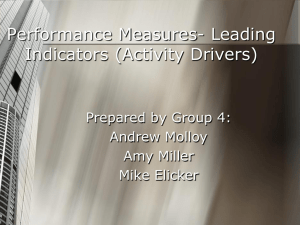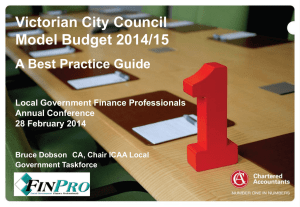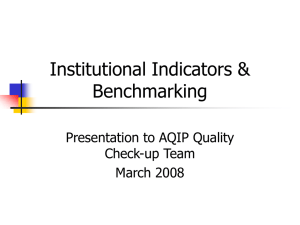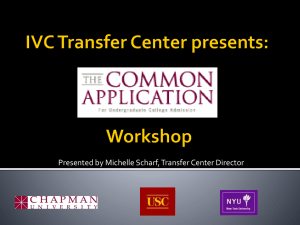Data Driven Leadership
advertisement
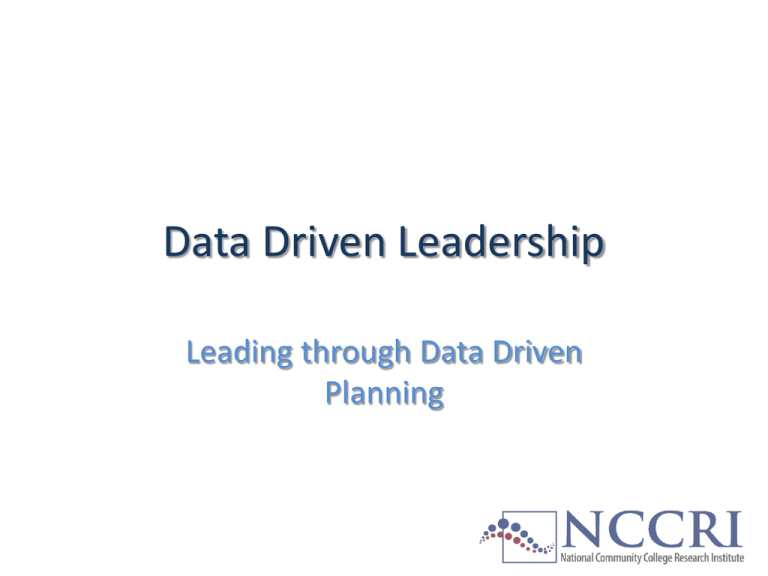
Data Driven Leadership Leading through Data Driven Planning Agenda • Using data in decision making • Determining data needs and capacity • Utilizing indicators for success and improvement • Data Driven Planning Process Data Usage in Decision Making • All of us make decisions based on information daily. • Inquiries you should be asking yourself. – What is the goal? – What resources are needed? – Do I have enough data to make the decision? – Do I have the right data to make the decision? – How do I evaluate the effectiveness of the decision? Data Inventory • Internal Data Sources – Financial Reports – Budget Reports – Demographic Data – Organizational Plans – Internal Independent Surveys Data Inventory • External Data Sources – Census data – Regional Economic Plans – National Reports • Trade Associations • Federal Reports – External Independent Surveys Data Inventory • Potential Data Sources – NWACC Master Plan – NWACC Fact Book (multiple years) – Current and past NWACC budgets – CCSSE and NCCBP data (national measures) – EMSI Data (Community Impact Report) – North Arkansas Council Regional Plan – Accreditation reports and documentation – NWACC Core Indicators Core Indicators Core Indicators • Student Progress – Student Goal Attainment – Persistence – Graduation Rates – Student Satisfaction Richard Alfred, Christopher Shults, and Jeffrey Seybert, Core Indicators of Effectiveness for Community Colleges, 3rd Edition (Washington, D.C.: American Association of Community Colleges, 2007), 23-42. Core Indicators • General Education – Success in Subsequent and Related Coursework – Program Learning Outcomes and Mastery of Discipline – Demonstration of General Education Competencies Richard Alfred, Christopher Shults, and Jeffrey Seybert, Core Indicators of Effectiveness for Community Colleges, 3rd Edition (Washington, D.C.: American Association of Community Colleges, 2007), 23-42. Core Indicators • Outreach – Regional Market Penetration Rates – Responsiveness to Community Needs Richard Alfred, Christopher Shults, and Jeffrey Seybert, Core Indicators of Effectiveness for Community Colleges, 3rd Edition (Washington, D.C.: American Association of Community Colleges, 2007), 23-42. Core Indicators • Workforce Development – Placement Rates – Licensure and Certification Pass Rates – Employer Satisfaction with Graduates – Client Satisfaction with Programs and Services Richard Alfred, Christopher Shults, and Jeffrey Seybert, Core Indicators of Effectiveness for Community Colleges, 3rd Edition (Washington, D.C.: American Association of Community Colleges, 2007), 23-42. Core Indicators • Contribution to the Public Good – Value Added to the Community Richard Alfred, Christopher Shults, and Jeffrey Seybert, Core Indicators of Effectiveness for Community Colleges, 3rd Edition (Washington, D.C.: American Association of Community Colleges, 2007), 23-42. Core Indicators • Transfer Preparation – Transfer Rates – Performance After Transfer Richard Alfred, Christopher Shults, and Jeffrey Seybert, Core Indicators of Effectiveness for Community Colleges, 3rd Edition (Washington, D.C.: American Association of Community Colleges, 2007), 23-42. Data Driven Planning Process Data Driven Planning Process • Constituent Groups – Learner Community – Business Community – Owner Community – Pre K-16 Community – College Community Data Driven Planning Process • Planning Areas of Focus – Quality Planning – Programming Needs – Facility Needs – Revenue Planning – Expense Planning Quality Planning • General assumptions regarding quality planning – Accreditation Key Dates – Opportunities from the HLC Systems Appraisal – Sixteen Core Indicators – Continuous Quality Improvement Efforts Programming Needs • General assumptions regarding program needs – New program needs – Existing program revisions – Regional planning – Personnel considerations – State regulations Facility Needs • General assumptions regarding facility needs – New construction – Renovations – Critical maintenance – Lease space – Technical Infrastructure – Cost Efficiency Revenue and Expense Planning • General assumptions regarding revenue and expense projections – Space allocation – Programs – Personnel – State and local funding levels – Performance based funding – Estimated headcount and retention levels Contact Information Dr. Ricky Tompkins Associate Vice President, Research and Planning Chief Diversity Officer Executive Director, National Community College Research Institute rtompkins1@nwacc.edu http://nccri.nwacc.edu http://www.nwacc.edu Thank You Any questions or comments?

